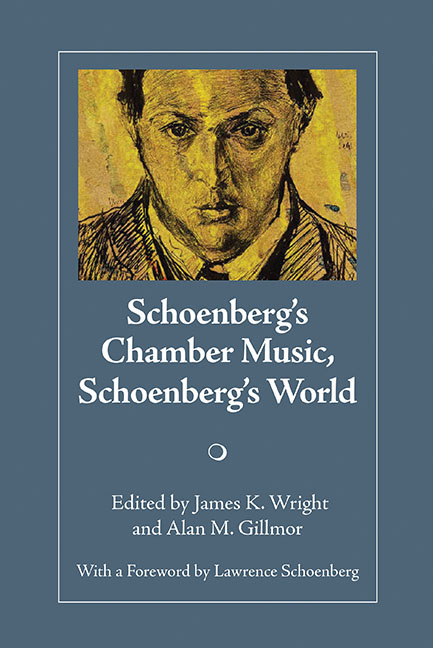Book contents
- Frontmatter
- Contents
- Foreword
- Preface
- HISTORICAL PERSPECTIVES
- ANALYTICAL PERSPECTIVES
- Schoenberg as Webern: The Three Pieces for Chamber Orchestra, III (1910)
- Juxtaposing Popular Music in the Second String Quartet, Op. 10
- A Chronology of Intros, an Enthrallogy of Codas: The Case of Schoenberg's Chamber Symphony, Op. 9
- Schoenberg's First Chamber Symphony, Formalism, and Adorno's Critique of Twelve-Tone Composition
- Precedents of Schoenberg's Compositional Practice in the Chamber Works of Joseph Haydn
- OTTAWA SYMPOSIUM AND CHAMBER MUSIC FESTIVAL PHOTOS
- PERFORMANCE, RECEPTION, AND INTERNATIONAL INFLUENCE
Schoenberg's First Chamber Symphony, Formalism, and Adorno's Critique of Twelve-Tone Composition
from ANALYTICAL PERSPECTIVES
- Frontmatter
- Contents
- Foreword
- Preface
- HISTORICAL PERSPECTIVES
- ANALYTICAL PERSPECTIVES
- Schoenberg as Webern: The Three Pieces for Chamber Orchestra, III (1910)
- Juxtaposing Popular Music in the Second String Quartet, Op. 10
- A Chronology of Intros, an Enthrallogy of Codas: The Case of Schoenberg's Chamber Symphony, Op. 9
- Schoenberg's First Chamber Symphony, Formalism, and Adorno's Critique of Twelve-Tone Composition
- Precedents of Schoenberg's Compositional Practice in the Chamber Works of Joseph Haydn
- OTTAWA SYMPOSIUM AND CHAMBER MUSIC FESTIVAL PHOTOS
- PERFORMANCE, RECEPTION, AND INTERNATIONAL INFLUENCE
Summary
Nowhere else is the secret agreement of light and progressive music more succinctly proven true than here. Late Schoenberg shares with jazz—and, incidentally, also with Stravinsky—the dissociation of musical time. Music drafts the image of a world that—for better or for worse—no longer knows history.
—Theodor AdornoI shall bring together two perspectives in this paper, one a formalist perspective growing out of my work with Schoenberg's concept of extended tonality, the other a critical perspective growing out of my work with the writings of Theodor Adorno. According to the first perspective, in his First Chamber Symphony, Op. 9, and in works like it Schoenberg explored what I shall call tonal centrality without pitches. By this I mean a kind of tonal orientation not centered on one, and only one, pitch or even on a central group of pitches, but instead a tonal orientation built on relationships created by intervals and patterns of intervals (which leads ultimately to an orientation built on the intervallic properties of a tone row). In works such as the First Chamber Symphony, the vehicle of tonal centrality shifts from tonic pitch orientation to tonic intervallic orientation. As a result intervals and interval patterns become the vehicles for tonal form, thus antedating Schoenberg's experiments with serialism.
Like Adorno, I find a premonition of serialism in Schoenberg's Symphony. Adorno's reading of nascent serialism differs significantly from mine, however, for mine is restricted to the framework of the introductory theme to the Symphony, while his treats the Symphony's first theme as a point of departure for a critique of the later twelve-tone technique in general. I shall begin my analysis of the opening measures to the Symphony, and turn to Adorno's critique later.
Example 1 is a short score reduction of the opening measures to the First Chamber Symphony. In the example, several pitches have been removed (E, C, and G-flat in m. 3, and A in m. 4). The pitches remaining show the prevalence of the interval of a perfect fifth (and its inversion the perfect fourth) in these measures. All the pitches in Example 1 can be seen as members of a series or cycle of fifth relations. I have sketched such a cycle as a simple listing of integers beneath the example.
- Type
- Chapter
- Information
- Schoenberg's Chamber Music, Schoenberg's World , pp. 133 - 148Publisher: Boydell & BrewerPrint publication year: 2009



